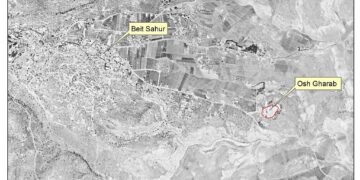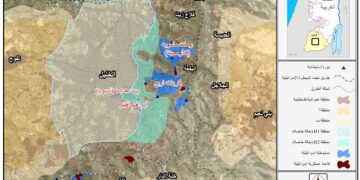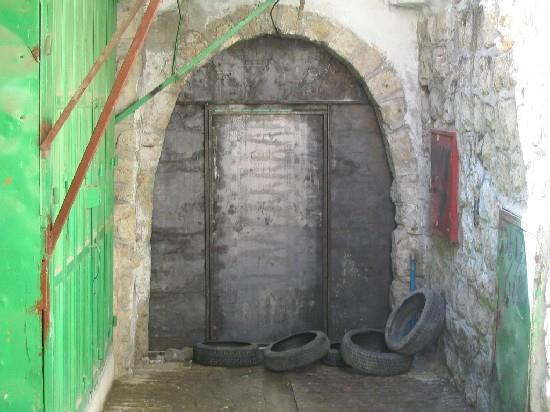The announcement by Sharon's government few weeks ago of the approval of the plan for constructing a Jewish colonial nucleus to be consisted of 21 housing units and a synagogue in Burg Al Laqlaq of the old city of Jerusalem comes as part of the displacement and replacement policy currently being implemented by the Israeli right wing extremist government in the occupied Jerusalem.
The plan for building this colony dates back to 1990 when, first, Ariel Sharon, the then minister of housing, disclosed it amidst celebrations on the 31st anniversary of the Israeli occupation and annexation of Jerusalem. According to Sharon's plan, 200 housing units were planned to be built at the site.
Second, at the time of Benjamin Netniyaho's government, another plan was ratified according to which a religious school, two residential buildings, six floors each, including parking lots and two underground tunnels were planned to be introduced to the site.
Following this, on May 24th, 1998, a group of colonists from the colonial organization ' Atarit Cohanim' under the protection of the Israeli army laid the corner stone for this colony at ten PM in the place called the ' Land of Maskub' whose total area is 2200 square meters belonging to the Russian Church in the holy land. Atarit Cohanim claimed that it had bought it from the colonial Himonita company affiliated to the Kern Ki'imet ( Israeli National Fund) which bought it from the White Russian Church in the year 1982 in a secret deal. According to this deal, the Israeli ministry of Agriculture exported citrus to the republic of white Russia at the cost of 2 Million US $ in change for the transfer of the land ownership to the Israeli ministry of agriculture. On the following night, Israeli colonists brought caravans (mobile homes) to the scene and settled in them.
Israeli greed in Burg Al Laqlaq
Site importance
Burg Al Laqlaq area is located in the north eastern corner of the old city of Jerusalem. It is part of the densely populated Islamic quarter. The total area of Burg Laqlaq is 11 dunums ( 11000 M2) , Located between Bab Al- Asbat (Lions Gate) in the eastern part of the wall and Bab Al- Zahera ( Herod's Gate) in the northern part of the wall. The area over looks the Haram Al- Sharif compound to the south, Rockfler museum to the north and Mount of Olives and Mount Scopus to the east and north east. See Map 1: location of Burj Al Laqlaq
According to researcher Hayel Sanduqa from Jerusalem, Burj Al Laqlaq area is consisted of the following land plots
1. Inheritance Waqf ( trust) of the family of Darwish ( 6435 M2);
2. Inheritance Waqf ( trust ) of the family of Al Khalidi ( 1440M2);
3. Charitable Islamic Waqf ( 291 M2) which is a strip of land stretching between Al Khalidi Waqf and Bab Al- Asbat (Lions Gate) along the western bank of the Wall;
4. The land of the family of Al Qara'in next to the northern part of the Wall ( Khallet Al Qara'in);
5. The land of Mubarek family which contains three houses and a kindergarten all seized by the Israeli occupation authorities under the pretext of being absentee property. Now, it is the site of the Jewish colony talked about above.
6. A strip of ' state land ' extending from the Mubarek family's land until Bab Al- Zahera ( Herod's Gate) next to the Wall. This site was seized by Jewish colonists and turned into a security observation post supervising all pedestrians entering Bab Al- Zahera( Herod's Gate).
7. The Land of Maskub whose total area is 2200 square meters belonging to the Russian Church in the holy land.
Israeli plans in Burj Al Laqlaq area
Following the laying down of the corner stone for the Jewish colony in Burg Al Laqlaq on May 24, 1998, anger broke out in the old city leading to confrontations between the Palestinian citizens, on one side, and the Jewish colonists and the army, one the other side, at the end of which the building process was halted on June 12, 1998 as a part of a deal reached between the Israeli government and Atarit Cohanim according to which excavation and digging works were allowed at the site. A security observation post was also allowed as part of this deal which was introduced next to the Wall in Bab Huta leading to Burj Al Laqlaq. After wards, the Israeli ministries of Infrastructure and Antiquities started a wide scale excavation campaign at the site.
( Photo 1: an Israeli security observation pint in Bab Huta on
the way to Burj Al Laqlaq– Photo courtesy of LRC)
This excavation campaign was led by the former minister of Tourism Bani Iyalon who is considered the chief supporter of Jewish extremist colonization organizations headed by Atarit Kohanim which persistently tries to get foot holds in every corner of the old city. So far, its members managed to seize dozens of homes and properties in 60 nuclei in the Muslim, Christian and Armenian quarters of the old city.

Photos 2 & 3: Israeli large cranes taking part in the excavation campaign
in Burj Al Laqlaq- photos courtesy of LRC)
The excavation campaign was just a preliminary step towards the final ratification of the establishment of at least 21 housing units for exclusive Jewish use in Burg Al Laqlaq area as mentioned above.
The plan aims at controlling this sensitive area and the two most important gates of the old city, Bab Al -Asbat ( Lions Gate) and Bab Alzahera ( Herod's Gate).
This Israeli project is considered, in particular, an Israeli penetration of the Islamic quarter which is relatively free of colonization nuclei. It is, also, sensitive in two ways: firstly, in strengthening security in the old city and, secondly, in bringing more colonists into the old city which, consequently, will create a demographic change for the benefit of Israeli colonists.
In case this project was completed, it will form the second largest colonialist block in the old city after Maghareba (Moroccan) quarter uta for the benefit of the Jewish quarter.
Waqf land
The Islamic Awqaf (Endowment affairs) authorities in Jerusalem confirmed that the Burg Al Laqlaq land is totally waqf land and contains Islamic and Byzantine antiquities. The Israeli government prevents Palestinians from building, renovating or extending already existing houses in the area under the pretext that the land is an archeological site. In the meanwhile, The Israeli authorities destroyed large areas of archeological importance to make room for the construction of Jewish quarters as had happened in Maghareba ( Moroccan) quarter of the old city.
Previous demolitions and vandalism
In recent years, more than ten structures have been demolished in Burj Al Laqlaq, including housing units and a center for disabled which was built by Canadian government's funding and affiliated to the Burj Al Laqlaq community Society which was set in fire at the hands of Israeli colonists in December 1998.
photo 4: The house of the family of Abu Ghazaleh
photo 5: Burj Al Laqlaq building destroyed by fire
(Photo courtesy of LRC)
Dubious positions:
Ori Shatreet, engineer of the municipality of occupied Jerusalem, opposed the current construction plan whence presented by the ministry of housing and construction on the basis that it didn't withdraw at least ten meters from the path of the Wall and because the height of the construction will surmount the height of the Wall it self. However, Shatreet, suddenly, changed his mind and became convinced of the plan after reducing the number of flats from 30 to 21, in addition to the synagogue, and recommended approval despite the fact that the planned buildings will consist of three floors which means that their height will surmount the Wall's.
A provocative project
The Israeli Yarushalaim newspaper, on its edition of May 27th, 2005, mentioned that this project which was prepared by the ministry of housing and construction will consist of a luxurious synagogue covered by a golden dome to compete with the prestigious Islamic Dome of the Rock.
Although the project represents a violation of all the principles of planning and construction inside the Walls of the old city it was approved by the municipality of occupied Jerusalem and by Israeli government.
The project was described by the Member of the municipality council, Papa Alanu, as being impractical and provocative which will initiate a third Intifada. From the organizational and planning point of view it constitutes a disaster as it contradicts all the principles of maintaining and preserving the old city and its urban master planning.
On the other hand, Knesset member, Ran Cohen, forwarded a message to Ishzaq Cohen in which he said the following: ' The essence of this plan is to get a political foot hold inside the old city. It is a barrel of explosives which might light the city and tear the already sensitive and tense relationships between Muslim and Jews of the Old city'.
It is worth noting that:
1. The site of Burj Al Laqlaq is an archeological one which should be preserved and kept as it is;
2. The Burj Al Laqlaq site is classified as green area prohibited for building;
3. The proposed construction plan represents a technical and engineering violation of the Old city's architectural and design patterns;
4. The proposed project is an aggression against the existing Palestinian houses as it will block sun and air from reaching these houses and will make no empty spaces between the houses and the newly planned structures which, in turn, will deprive residents of any privacy.
The Land Research Center calls for the following:
1. The UNSECO should work for the preservation of archeological and historical sites from Israeli aggression;
2. The international community and all governmental and non governmental world organizations should assume responsibilities and pressures Israel to stop its acts of changing realties on the ground at the expense of Palestinian rights.
3. The international community should provide protection to the Palestinian people, their land, history and cultural heritage.
Prepared by
The Land Research Center
LRC


















